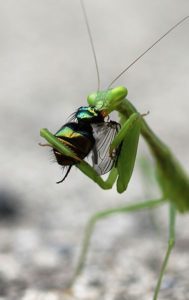The praying mantis is a voracious predator. It relies mostly on ambush, but is lightning quick. Comprised of 2200 hundred species worldwide, they vary widely in their appearance, generally engaging in mimicry of vegetation or some other chameleon-like sneaky behavior. They are considered beneficial in that they consume a good deal of problem insects, but since they are generalists in their feeding, some good insects will also fall prey. They also engage in cannibalism. The jury is still out on whether or not purchasing mantids is cost effective, but an initial launch would certainly be worth it in terms of pure scientific pleasure. The mantid is the only predator which feeds at night on moths (most moths are active only after darkness) and the only predator fast enough to catch mosquitoes and flies.


Ladybugs, or ladybirds are neither birds nor bugs. These busy little beetles are quite well known as beneficial insects, and it is fully deserved. There are indigenous species, but some were also imported by the USDA to combat pests. They are very useful in the orchard primarily as a hunter of the aphid menace. Here in Walden they are constantly in residence on our plum trees (which aphids relish). Ladybird beetles will predate as adults and as larva.
The following is courtesy of the Ohio State University Extension:
Lady beetles, often called Ladybugs or coccinellids, are the most commonly known of all beneficial insects. In Europe these beetles are called “ladybirds.” Both adults and larvae feed on many different soft-bodied insects with aphids being their main food source. Ohioans like lady beetles so much that the Convergent Lady Beetle became the official state insect in 1975.
Identification
Adult lady beetles are domed shaped, oval or convex, often shiny with short legs and antennae. Wing covers are dark, reddish-orange to pale yellow, with or without black spots or irregular marks. Some are solid black or black with a red spot. The head is concealed from above. They have three distinct tarsi (feet), and range from 1/16 to 3/8 inch long. Larvae are elongate, somewhat flattened, and covered with minute tubercles or spines. Most larvae have large, sickle-shaped mandibles (jaws) and resemble tiny, six-legged alligators blue-black with orange spots. Tiny, yellow, oval eggs are laid upright in clusters of 10 to 50 on undersides of leaves.
Life Cycle and Habits
The length of the life cycle varies depending upon temperature, humidity, and food supply. Usually the life cycle from egg to adult requires about three to four weeks, or up to six weeks during cooler spring months. In the spring, overwintering adults find food, then lay from fifty to three hundred eggs in her lifetime (tiny, light -yellow eggs are deposited in clusters of 10 to 50 each) in aphid colonies. Eggs hatch in three to five days, and larvae feed on aphids or other insects for two to three weeks, then pupate. Adults emerge in seven to ten days. There may be five to six generations per year. In the autumn, adults hibernate, sometimes in large numbers, in plant refuse and crevices.
Amount of Food Consumed
Lady beetles, both adults and larvae, are known primarily as predators of aphids (plant lice), but they prey also on many other pests such as soft-scale insects, mealybugs, spider mites and eggs of the Colorado Potato Beetle and European Corn Borer. A few feed on plant and pollen mildews. One larva will eat about 400 medium-size aphids during its development to the pupal stage. An adult will eat about 300 medium-size aphids before it lays eggs. About three to ten aphids are eaten for each egg the beetle lays. More than 5,000 aphids may be eaten by a single adult in its lifetime. The lady beetle’s huge appetite and reproductive capacity often allow it to rapidly clean out its prey.


